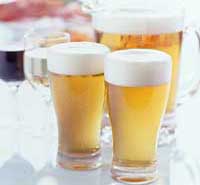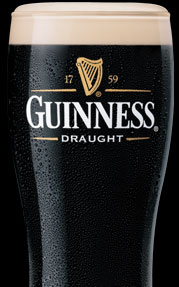Main
Refraction
Reflection
Scattering
Bubbles
Links
The Bubbles

So what exactly does one see when he/she looks at a freshly poured glass of beer? One usually sees the foam collected at the top and lots of bubbles floating up to the top, where they gather together. Upon closer inspection one can see that the bubbles are made of air, and that the bubbles are surrounded by liquid all around.
Let's assume that the ray of light coming in from the sides are already refracted/reflected and they are coming in parallel to the horizontal axis. Also remember that the ray of light has already gone through the glass ( another medium ) and the beer (water). Let's see what happens graphically.
Here is an example of 5 light rays being refracted:
Now in the following two pictures, the ray is refracted, then reflects inside the bubble once, then refracts again:
In these pictures, we have isolated one single bubble in the beer. As the light enters the air bubble, it goes through a different index of refraction ( index = 1 ). It then refracts and then reflects inside the bubble, and then when the light ray exits the bubble, it enters the beer again, which means it refracts again.
This picture shows the same thing, except the ray hits the bubble in the lower half:
The bubble acts like a divergent lens. When the ray enters the bubble, the light ray is diverged because it is entering a medium where the index of refraction is lower than where it was before. Now let's see what happens when that ray exits that bubble:
Since there are many bubbles near the one bubble, the light ray is reflected and refracted many times over, in this instance, the ray is is bent towards the bottom. But that is only one instance of the ray. The multitude of rays reflecting and refracting with the bubbles is called Mie scattering. Mie scattering is the reason why the bubbles appear lighter in colour than the beer. Because scattering affects not only on red light ( in my example ), all the colours are affected almost equally. Hence, most bubbles are light in colour.
Now remember the property of reflection. Some light rays, when initially hitting the bubbles of air, reflect off the thin layer of fluid around the bubble and bounce back. These are the bubbles that are near the surface. The picture below shows 5 light rays being reflected.
Remember that the light ray is reflected in such a fashion that the angle of incidence is equal to the angle of reflection. This is due to the law of reflection, discussed in the Reflection of my website.
So with a combination of refraction, reflection and Mie scattering, light rays ( and waves ) that hit the bubbles interact / react with the bubbles in beer, thus making them appear white in colour. Actually upon closer inspection, the bubbles of such fluids have a slight beige colour instead, and this is due to the colour of the dark liquid itself.

In the interests of mathematics, I performed this experiment many times in order to see if this is indeed the case.